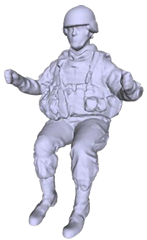Human-Autonomy Interaction
Annual PlanSoldier-Centered Vehicle Seating Design Tools based on Measurement and Modeling of Soldiers
Project Team
Government
Katrina Harris, U.S. RDECOM-TARDEC
Industry
Pete Kempf, AM General
Project Summary
Project began June 2014 for a duration of 1 year.

The design of tactical vehicles to maximize crew performance and survivability is hampered by a lack of detailed data on the postures and positions of soldiers. Civilian design tools cannot be readily applied because military populations differ in body dimensions from civilians, the task conditions do not match typical civilian situations, and soldiers frequently wear personal protective equipment that affects body shape, posture, and position.
The design procedures for passenger cars, light trucks, and commercial heavy trucks are guided by industry-standard tools based on analysis of detailed data from drivers and passengers. Some of these tools are codified in SAE practices, including SAE J941 (driver and passenger eye location) and SAE J4004 (driver-selected seat position). U-M researchers have led the development of these and other standards based on research supported by the automotive and truck industries. Posture-prediction models developed at the U-M Transportation Research Institute (UMTRI) are used in major human modeling software systems including the Siemens Jack model that is widely applied to tactical vehicle design analysis. Variants of these posture prediction models have been developed for realistic positioning of crash dummies.
This program will apply the human measurement methodologies developed for passenger cars and commercial trucks to develop human-centered design tools for tactical vehicles. The data collected will be the first available to quantify soldier seated postures in realistic driver and crew environments and will provide critical input to the design of energy absorbing seats and occupant restraints. This will be directly applicable to the assessment of current vehicles and the design of new vehicles. The results will provide the foundation for improvements in current military design specifications as well as the basis for new computer-aided design tools for use in human modeling software systems such as Jack.
Publications:
- Matthew P. Reed, Sheila M. Ebert, “The Seated Soldier Study: Posture and body Shape in Vehicle Seats”, Final report by Biosciences Group, University of Michigan Transportation Research Institute (UMTRI), October 2013.
Download at: http://deepblue.lib.umich.edu/handle/2027.42/109725
References:
- Parkinson, M.B. and Reed, M.P. (2009). Creating virtual user populations by analysis of anthropometric data. International Journal of Industrial Ergonomics, 40:106-111.
doi: 10.1016/j.ergon.2009.07.003 - Reed, M.P. and Parkinson, M.B. (2008). Modeling variability in torso shape for chair and seat design. DETC2008-49483. Proceedings of the ASME Design Engineering Technical Conferences. ASME, New York. doi: 10.1115/DETC2008-49483

